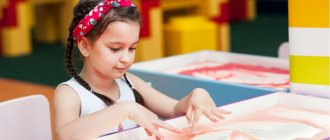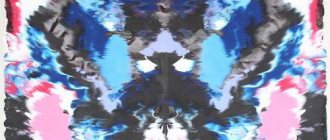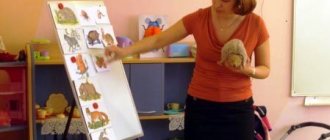How to draw a sleeping cat step by step
- Draw a large circle with a smaller circle inside it.
- Draw two small triangles to the inner circle. These will be our cat's ears.
- Inside the circle we decorate the eyes, nose and mustache. This is done using arcs, triangles and lines.
- Draw the tail. The drawing is ready.
Drawing Cats in gouache step by step with photos for children
Gouache cat using unconventional painting techniques. Step-by-step drawing for children with photos
Master class on drawing. Kitty. Author: Vera Aleksandrovna Pavlukhina, additional education teacher, MAOU DO Youth Center “Zvezdochka”, Tomsk Description: this master class will be of interest to additional education teachers, creative people, children of senior preschool and primary school age. Purpose: sample for drawing classes, painting for office decoration, sketch for decoration. Goal: creating a simple gouache drawing using non-traditional drawing techniques Objectives: to promote the development of interest in fine art; to improve skills and abilities to work with gouache in different techniques (non-traditional and traditional); to instill accuracy and perseverance Materials:
blue thick paper A4, a simple pencil, a small foam sponge - 2 pieces (foam rubber “poke”), brushes (thin and wide), palette, glass, gouache, rag. In my house there lives a fluffy Kolobok, a very kind red cat - long eyelashes.
In the morning, getting up, washing his mustache with his furry paws, he loves to run and play in the room with the guys. M. Piudunen
Let's draw the outline of the cat with a simple pencil.
Let's finish drawing the eyes, nose, cheeks, tongue and paws.
We put ocher on the palette with a wide brush and use a foam rubber poker to draw the outline of the cat, gradually painting over the entire cat. We try to make frequent pokes, randomly, turning the poke in all directions, so that we don’t have any gaps between the pokes. In the area of the eyes, cheeks and nose, we leave less noticeable pokes so that traces of the pencil can be traced through them. Add a little brown to the ocher palette and make sparse pokes with a foam sponge.
We apply white gouache with pokes on the paws and cheeks.
Then add some elongated lines of dark ocher color
We wash or wipe our hands. With a brush and black gouache we draw the outline of the paws, claws, and fur.
Then draw green eyes and a pink nose with a thin brush.
Add a mustache, draw eyes, eyebrows and fur.
After the gouache has dried, add highlights to the eyes and nose.
All that remains is to add a little by poking the dark spots.
The kitty is ready.
Vase decor option. Cover the surface with one layer of primer and after drying, apply a pattern to the surface with acrylic paints and contours.
We recommend watching:
Non-traditional technique of drawing flowers for preschoolers Summary of a drawing lesson in the senior group Non-traditional drawing techniques for preschool children on the topic: Winter Drawing on salt in kindergarten
Similar articles:
Non-traditional drawing technique in preschool educational institutions. Drawing with a piece of textile
Our friend is a cat.
Methodological development of an art lesson
Topic: Our friend is a cat.
Class: 1
Goals:
1. Educational: learn to draw cats according to the proposed diagrams, convey their character;
2. Educational: to help instill in younger schoolchildren a love for animals, to develop the ability to work in a team.
3. Developmental: promote the development of associative thinking, develop students’ creative abilities and imagination.
Equipment: an exhibition of books, drawings about cats, samples of drawings, cards with information about cats hung on the chalkboard.
For practical work: a simple pencil, colored pencils, drawing paper.
Organization of workplaces: desks are arranged in three rows, with equipment for practical work on the tables.
Recommendations for group composition: students are divided into 3 groups as desired.
During the classes:
I. Opening remarks : Guys, today we are visiting the Cheerful Pencil.
Today's lesson is dedicated to our beloved four-legged friends, and a riddle will help us find out which of them. So, guess the riddle:
This beast lives only at home,
Everyone is familiar with this beast.
He has a mustache like knitting needles.
He purrs and sings a song,
Only the mouse is afraid of him...
Did you guess it? Who is this? (cat)
II. Teacher's story: A cat, an affectionate creature with big eyes, cannot leave anyone indifferent. There are more than 400 million domestic cats on our planet, and they are unevenly distributed. The United States ranks first in the number of cats, but there are none in Gabon (a state in Africa). In Australia there are 9 cats for every 10 people.
A cat's vision is 6 times sharper than a human's. She recognizes a familiar person 100 meters away.
A cat's hearing is 3 times more perfect than a human's.
The cat has an excellent visual memory.
Cats can predict earthquakes, volcanoes, fires, bombings. The ability to predict the approach of danger during the war was so vital that a special medal “We Serve the Motherland” was established. The award was given to cats that helped save someone's life.
The largest cat is the Ragdoll breed: weight reaches up to 9 kg. And the male named Himmi weighed 21 kg. Cats typically weigh 2.5 kg.
Cats live on average 20 years. And the cat gives birth to 3-5 kittens. But there are exceptions. A cat named Tarawood Antigone (Great Britain) is included in the Guinness Book of Records for giving birth to 19 kittens at once. And the cat Dusty (USA) lived 17 years and gave birth to 420 kittens during her life. Kitty the cat lived for 32 years, and at the age of 30 she gave birth to two kittens, becoming the oldest cat - mother.
Cats catch mice. The Tauser cat was recognized as the best mouse catcher. During her life, she caught 28,899 mice: an average of 3 mice per day.
The cat can be found in the circus and at exhibitions. Cats are our little brothers. We need to take care of them not only when we are interested in them, but always.
Poets, writers, storytellers have dedicated many works to cats.
Do you know them?
Let's conduct a quiz on a connoisseur of works about a cat.
Quiz
1. You are eating a sandwich wrong, Uncle Fyodor. You hold it with the sausage facing up, but you have to put it with the sausage on your tongue. (E. Uspensky “Uncle Fyodor”).
2. He looks and his cat Epifan catches fish himself. He lies flat on a log, puts his paw in the water, doesn’t move, doesn’t even blink. And when the fish swim out in a school from under the log, he - one! - and picks up one fish with his claws. (E. Charushin “Epifan”)
3. – Go away! I can't bear it as it is! You see, I’m busy with science, so scurry and don’t meow! (B. Zakhoder “Harmful Cat”)
4. – I picked a twig and went into the hole. And from there it will hiss! I backed away. Wow! (B. Zhitkov “Stray cat”)
5. – That’s good...Will there be birds? I love birds. (V. Suteev “Capricious Cat”)
6. – Your Majesty, you are welcome to the castle of the Marquis de Carabas! (C. Perrault “Puss in Boots”)
7. -You praised me three times, and now I can always, and always, and always drink warm white milk three times a day. (R. Kipling “The Cat Who Walked By Himself”)
Customs and signs about cats.
There is a custom in Rus': the owner lets a cat in first into a new house or apartment. She personifies home comfort and “washes” guests. There are other signs associated with the cat:
- The cat washes itself with its paw - you need to wait for guests.
- A black cat ran between someone - promises trouble.
- If you kill a cat, you won’t see any luck in anything for seven years.
III. Working on the topic.
A lot of amazing things can be said about our pet. But artists speak not with the help of words, but with the help of a pencil, paints, etc. The depiction of animals is a genre of fine art, which is called animalistic, and artists are called animalists.
(show pictures)
So we will tell you about our cat on paper in the form of graphics; we will draw the drawing using a pencil. But first, let’s do some physical education.
Our cat Muska loves to relax:
Jump, jump, run, release your claws.
And now you and I will also rest.
We will also jump, run and gallop.
We will work in groups. You chose the group at will.
The children of group 1 will have to draw a cat with kittens. The contours of the drawing of a cat and kitten have already been determined for you. All that remains is to choose yellow and black pencils. Carefully and correctly, alternating black and yellow colors, paint over the cats.
The children of group 2 need to draw a cat that has discovered a mouse and is preparing to jump. We draw, following the sequence.
1. Determine the size of the drawing.
2. Draw a round body.
3. In the lower part of the body, draw the head, also in the shape of a circle.
4. Draw the ears. To do this, draw two vertical lines just above the middle of the head, and then connect each line to the top of the head so that the forehead is visible.
5. Draw the eye inside the smaller circle. They are round, draw oval-shaped pupils.
6. Draw the nose in the shape of a triangle.
7. Below the nose is the mouth.
8. Draw a mustache in the form of straight slanted lines.
9. On the left side of the body, draw a tail in the shape of an elongated thin oval.
10. Draw the paws in the shape of a semicircle.
11. Paint over the drawing as you wish.
(demonstration of drawing sequences and sample on the board)
Children from group 3 will draw a cat resting after a successful hunt. We also draw in a certain sequence.
1. Determine the size of the drawing.
2. We outline the size of the head and torso.
3. Draw an oval-shaped head. It is smaller than the size of the body.
4. Draw the body of the cat using a rounded line, draw the chest using a curved line.
5. Draw the ears, eyes, mustache, and tail in the same sequence.
6. We depict the front legs without claws.
7. We will depict the fur using dashes.
8. Paint it any color.
(demonstration of drawing sequences and sample on the board)
IV. Independent work of students. (calm melody sounds)
V. Lesson summary.
The teacher displays the students' work on the board and discusses the most successful drawings with the children.









